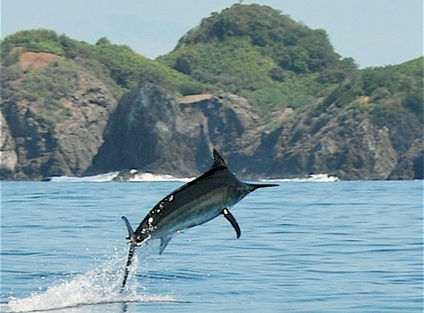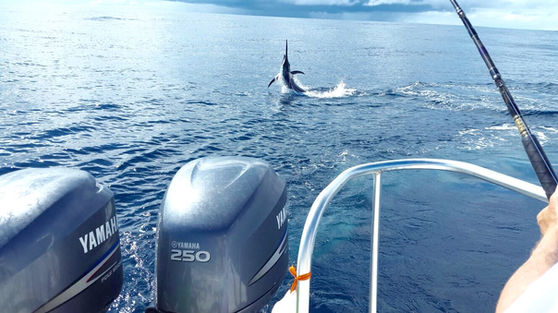Panama Fishing Information

Fishing Information

Panama Fish Species
A commonly passed on legend in Panama is that there was a fishing village that held the name "Panamá", which reportedly meant "an abundance of fish", when the Spanish Conquistadors first landed in the area. The exact location of the village is unknown but we have reason to believe it was in the Gulf of Chiriqui. There are 50+ species of game fish to be caught here, and 250+ World Records have been set in Panamanian waters!
Other than Marlin, Yellowfin Tuna, and Roosterfish that we already featured… a few of our more frequently caught types of fish here at PSFL are:
MARLIN
Marlin fishing in Panama at the Panama Sport Fishing Lodge, the closest lodge to the marlin hot spots in the Gulf of Chiriqui, consistently produces trophy catches. We are the closest to the marlin hot spots at the Hannibal Bank, Isla Montuosa, and the 100 fathom line that runs along the southern edge of the Gulf of Chiriquí. These locations consistently tend to be the most productive areas to find Black and Blue Marlin. The underwater ledges and bottom structures at these offshore spots shoot up from thousands of feet and provides cover and slack current that bait fish like to congregate in. These bait fish are the staple food of these big Pelagic type fish. And, when there is bait around… odds are that your Grand Slam of big fish is waiting to be caught.
Although we catch Black Marlin every month of the year, the best time for Marlin here tends to be November through February and July through September. November through March we see the most quantity of Marlin while Panama Marlin fishing. Black Marlin, Blue Marlin, (the occasional Striped Marlin), and also Giant Pacific Sailfish are found in numbers these months around the bait concentrations at Hannibal Bank and Isla Montuosa. July through September, the beginning of the “green season”, tend to be great months for BIG Black Marlin. We see many these months at the “high spots” around Hannibal Bank and Isla Montuosa as it is believed to be the time when the big females come around to spawn. Also a superb time to fish… as there is less boat traffic offshore this time of year.
We use a few different methods here when Panama Marlin Fishing: live bait, dead bait, or trolling artificial lures. Depending on the conditions, all of these methods can be highly effective. Most Marlin fishing days usually go like this… On our way to the fishing grounds we will always keep our eyes open in hopes of spotting bait fish. If bait fish such as Bonitos, Skip Jacks, or adolescent Yellowfin Tunas present themselves we will try to catch a number of them and store them in our Tuna Tubes. The Tuna Tubes are a type of live well that will keep the baits alive until we go to fish with them. If we are lucky enough to find, catch, and fill our Tuna Tubes with enough baits then we will go and scout out a “fishy” area. Once we have determined the area to fish we’ll rig the live baits and slow troll them in hopes of attracting a Marlin to eat. And nothing is more exciting than watching a Marlin rising up and crash live bait! If the live bait method is not productive then we have the option to troll a combination of dead baits (rigged Ballyhoo) and artificial lures. Trolling artificial, in conjunction with rigged Ballyhoo, is just as effective as live bait. It gives us the ability to cover larger areas to find the fish as we troll much faster than we would with live baits. It is still common, and equally exciting, to see a Marlin come up behind a trolled artificial lure but you have to pay close attention as the action happens much faster!

TUNA:
The fishing for Yellowfin Tuna, here in the Gulf of Chiriquí, Panama, is undoubtedly some of the best blue water fishing in the world! Each year like clockwork, huge schools of Yellowfin Tuna, along with thousands of Spotted Dolphins, migrate north up into the gulf feeding on spawning Baitfish, Squid, and Crabs. Our lodge’s island location, 12 miles offshore, is the perfect spot for short runs to the Panama Tuna fishing grounds in the Gulf of Chiriquí. Come and fish with one of our 6 captains and their crew on Panama Sport Fishing Lodge’s 7 boats for the most sought after and best tasting fish… the Yellowfin Tuna.
Starting in February the Tunas start to show up down around the southern tip of Isla Jicarita and begin to slowly work their way north up into the Gulf of Chiriquí. As the months progress they move further and further north. By late March they are near and around Hannibal Bank and Isla Montuosa. Usually by around April, May, and June, depending on water temps, the Yellowfin Tuna season here is at its peak This is when we see the most “Tuna Storms” or Tuna boils…when we come across areas of Porpoises and Tunas feeding like madness on bait balls they have insanely pushed to the surface! The Tunas generally hang around in the masses until July or August and we will still catch the occasional Holiday Tunny during the later months.

GRAND SLAM:
If you’re after the appetible Grand Slam, December through mid-February and July through September is the best time. Your Grand Slam may include any three of the following species: Black Marlin, Blue Marlin, Sailfish, and occasionally a Striped Marlin. A Super Slam is any four of the billfish species.
FISHING AT Panama Sport Fishing Lodge®: At PSFL, most of the fishing is 20 to 50 miles offshore in decently calm waters. The most challenging seas (4 to 6 feet) of the fishing season normally occur from January through March. Our crews are all local and have been fishing these waters for over 20 years.
INSHORE FISHING: is excellent from mid-March through August. Record-sized Roosterfish, Cubera Snappers and a host of other species are abundant along the coastline. It is not uncommon to catch 10+ species on a good day. Giant schools of mid-sized Yellowfin Tunas also show up during the end of green season.
BOATS: The Lodge has a fleet of 7 center counsel fully rigged; 35-foot boats, each boat has tuna tubes and live bait well combos, downriggers, and outriggers. PSFL also has 2 mother ships, which hosts up to 8 anglers. The enclosed, air-conditioned yachts provide the best option pricewise and you will have more time to create fish fighting memories to share.
CREWS: The guides are from the area and have been fishing these waters for over 20 years. They speak limited English. The captains and mates are all home grown in Panama and are trained in house at the Lodge. To become a captain, you first have to become a mate and work your way through the ranks. Mates go through a rigorous training program which takes around two years to complete. Working their way from the tackle shop where they learn rigging, knot tying, and maintenance of the rods and reels. After six months of land training, it’s time to hit the water. On the boat, they learn to rig baits, hook-up fish, and the art of running a deck. The Lodge takes great pride in our deck hands being some of the best in the business. After 8 -10 years, then a mate is eligible to be promoted to Captain. Many of our captains have been on the water for over 20 years and have a large following and the respect of many international anglers and captains alike.
FISHING TACKLE: We furnish all of your fishing tackle, which include Shimano reels and Custom Rods by Dru rods /Shimano 30 & 50-pound class rods. They also have spinning rods and reels with 65 lb braid. Downriggers, braid, and Aftco fighting harnesses, rod belts, lures, and teasers, leaders with circle hooks, some plugs and gaffs are also included. The boats are stocked with a variety of poppers, jigs, and plugs; however, you can plan on bringing down some of your own secret weapons if you like.
Note: If you wish to bring your own rods and reels, please let us know in advance to plan accordingly.
We do not stock or provide any fly fishing equipment. Please get in touch with us if you are interested in fly-fishing Gulf of Chiriquí. We can give you some tips and help with what gear to bring for your blue water adventure.
A TYPICAL FISHING DAY: Fishing days start early, wakeup call at 5:30a.m. Hot coffee is a few steps from your door. An American breakfast is served at 6:00a.m. The boats leave the dock no later than 6:30 a.m. You’ll have access to water, soda, beer and snacks aboard the boat. A lunch consisting of wraps, sandwiches and fruit will also be prepared for you. All rods out of the water by 4:00 pm. Arrive back to docks between 5:00 and 6:00pm. Appetizers served when you arrive. Dinner is served at 8:00pm.
3-6 DAY PACKAGES
Great opportunity to target inshore or offshore fishing while still leaving a little time to enjoy the rest of the amenities available at the lodge. With accommodations for up to 30 anglers, book a lodge stay during our peak season December - June or for green season July - November.
MOTHERSHIP
BOCA CHICA
Want to wake up and able to fish immediately without any too much drive time to the fishing grounds? Book a mothership stay where you'll be anchored off of Isla Coiba with all the great all inclusive perks of the lodge, but more time for fishing.







